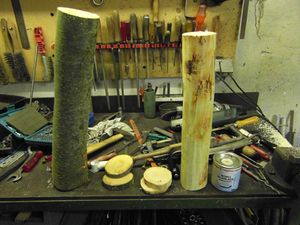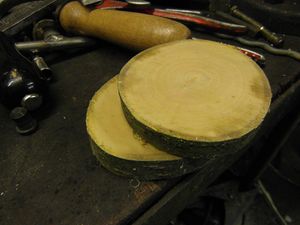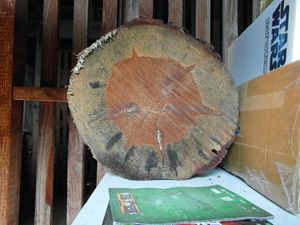Project:Drying Timber
From CoMakingSpace Wiki
| ProjectInfoBox Drying Timber | |
|---|---|
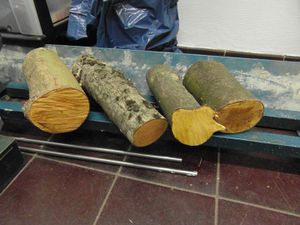
| |
| Status: | ongoing |
| Release Date: | started in 2016, first products in 2018 |
| Initiator: | Lukas |
| Team: | Luzian; kind contributions from Airlag & Narquadah |
| Materials Used: | various kinds of wood; wood glue, paraffin, clear lacquer |
| Tools Used: | chainsaw, pocket chainsaw, hacksaw, drawknife |
| Approx. Cost: | mostly time & space |
Before actively looking for sources of unprocessed timber or rough-cut boards for woodturning blanks or projects like a "river table", I want to experiment with drying and storage techniques to see which works best. Drying too fast will cause the wood to crack while incomplete drying allows fungi to grow.
Here you'll find my experiences! Different woods are tested as they probably won't behave alike.
- some photos
-
apple logs in late 2016
-
apple discs in late 2016
-
the pine log in late 2016
Progress/Results
| Species | (Early) Photo | Approx. Dimensions | Source | Treatment | Storage | Outcome | Use | Notes |
|---|---|---|---|---|---|---|---|---|
| yew | 
|
two logs | Airlag | none | Lukas' workbench since 2019-2-6; garage approx. 5 years before that | |||
| pine | 
|
log | forest (left over by workers a few weeks before <???>) | bark mostly gone already, no further treatment | uninsulated attic since 2016-9-25 | not too great | (poor) chop block, then firewood (2017-5) | first "attempt" without any effort, no big surprise... |
| beech | 
|
log | sawn from fallen tree <???> | one side splintered, no special treatment | uninsulated attic since <???> | planned: mallet head | ||
| apple | 
|
three logs approx. ø 8 × 45 cm | orchard | cut into pieces for various approaches:
|
|
planned: woodturning | ||
| cherry | small piece | gardener at the JKI Dossenheim (2016-12) | cut faces painted after two months outside
|
|
||||
| maple | small piece | gardener at the JKI Dossenheim (2016-12) | cut faces painted after two months outside
|
|
||||
| beech | small log | sawn from fallen tree (2017-2-5) | cut faces painted after two weeks outside
|
|
"marbled" with some kind of fungus (spalting) | |||
| Robinia | 
|
large log | sawn from fallen tree 2017-10-21 | (top) cut face painted when brought to the Space
|
|
nice overall, some cracks (could have started before treatment) | wedding cake stand (2018-4) | |
| apple | 
|
small log | uncle's firewood pile 2018-10-7 (cut approx. 6 months earlier) | cut faces sealed 2018-10-8
|
balcony until <???>, then Lukas' workbench | |||
| ash | 
|
small log | uncle's firewood pile 2018-10-7 (cut approx. 6 months earlier) | cut faces sealed 2018-10-8
|
balcony until <???>, then Lukas' workbench | |||
| beech | small log | uncle's firewood pile 2018-10-7 (cut approx. 6 months earlier) | cut faces sealed 2018-10-8
|
balcony until <???>, then Lukas' workbench | ||||
| ash | 
|
large log with "handle" branch | roadside (left over by workers a few days before 2018-3-3) | cut faces covered when brought to the Space | put under Lukas' workbench immediately (2018-3-3) | planned: axe/hammer handles | ||
| unknown - maybe apple? | small log | spring cutting in gardens 2019-1-29 | cut faces covered with two coats of wood glue 2019-2-4 |
|
||||
| unknown - willow, linden, poplar, ash, |
two thick logs:
|
Narquadah (cut around 2018-10) | cut faces covered with wood glue 2019-2-13 | put under Lukas' workbench immediately; removed upon discovery of boring beetles 2019-2-27; brought back in 2020-3-21 | probably failed due to insect infestation - waited too long after felling | planned: bowl turning | ||
| zwetschge (yup, that's the English name) | 
|
nearly an entire tree:
|
grandma's garden 2019-2-18 | cut faces covered with tree wound sealant (silicone or wood glue-based by the smell of it?) on the same day
|
carport "attic"
|
planned: at least some furniture & knife scales | ||
| pear | two medium branches:
|
grandma's garden 2019-2-18 | cut faces covered with tree wound sealant (silicone or wood glue-based by the smell of it?) on the same day
|
carport "attic" | planned: ornamental woodturning | |||
| tree of heaven (Götterbaum) | leftover piece from log splitting | Micha/scrap bin 2019-5-29 | split 2019-5-28, no further treatment | Lukas' workbench after splitting | planned: carving or woodturning | |||
| wild cherry | 
|
two logs: not measured yet | garden 2019-10-26 | faces sealed with wood glue 2019-10-27 & 2019-10-28 (3x over existing small checks); smaller log stripped of its bark | balcony since 2019-10-27; Lukas' workbench since 2020-3-21 | stripped log soon became cracked, the one with intact bark "survived" the balcony period well | planned: furniture | |
| cherry | curved young log | garden ______ | faces sealed with wood glue | 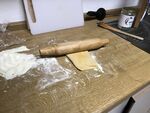 |
Further Ideas
- get/make a moisture meter
- there is an Instructable on kiln drying at home, but it seems to require lots of space and electricity
- try cheaper and ecologically safer options than clear lacquer for painting cut faces
- wood discs can reportedly be placed in a bucket of sawdust to dry, be treated with "wood hardener" or weighed down in a stack and rotated every few weeks
- not tried yet, but as they are really hard to dry it's best to not cut the timber into discs when still fresh!
- thin-walled bowls turned out of "green", non-dried wood can supposedly by dried in triple paper bags without checking (cracking) [1]
- completely different approach, could allow to skip the drying step for some projects?
- write down some of this "theory" part more nicely
- drying speed with grain, role of bark, importance to cover faces
- start with long pieces - gives you room to cut off cracked ends
